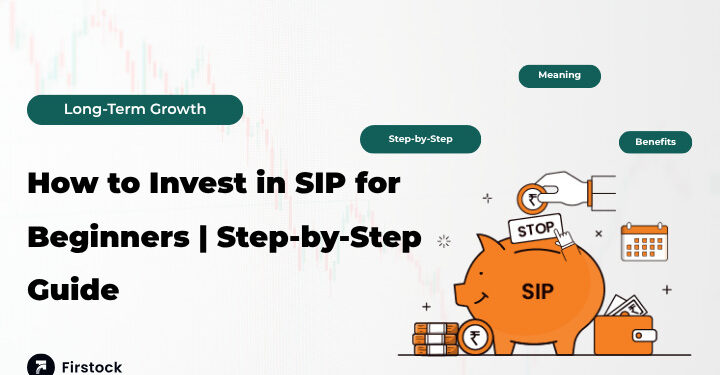How to Invest in SIP Without a Broker: A Complete Beginner’s Guide
Introduction
Ever wondered how people build wealth steadily over time without taking big risks? The secret often lies in Systematic Investment Plans (SIPs) — a simple, disciplined way to invest in mutual funds. You don’t need a fancy broker or deep financial knowledge to start. You can invest in SIPs directly, from your phone or laptop, using secure online platforms and stock trading apps.
Think of SIP as planting a tree — you water it regularly, and with time, it grows strong and fruitful. Similarly, with consistent SIP investments, your money grows steadily through the power of compounding.
In this guide, we’ll break down everything you need to know about how to invest in SIP without a broker, from its meaning and benefits to step-by-step guidance.
Learn how to invest in SIP without a broker. Understand sip investment meaning, sip full form, if investment in sip is good or bad, and the best stock trading app.
What is SIP? – SIP Investment Meaning and Full Form
Let’s start with the basics. SIP stands for Systematic Investment Plan.
It’s a method of investing a fixed amount of money regularly (monthly, quarterly, etc.) into a mutual fund scheme. Instead of investing a large sum at once, you contribute smaller, manageable amounts over time.
SIP Investment Meaning
SIP allows you to invest systematically — just like setting a monthly savings goal. It’s a disciplined approach that helps you build wealth gradually.
SIP Investment Full Form
As mentioned, SIP stands for Systematic Investment Plan, a popular method in India for long-term wealth creation through mutual funds.
How Does SIP Work?
When you invest through SIP, a fixed amount is automatically deducted from your bank account and invested into your chosen mutual fund scheme.
Here’s what happens behind the scenes:
- The fund manager invests your money in stocks or bonds.
- You receive mutual fund units based on the Net Asset Value (NAV).
- Over time, as the market grows, your investment value increases.
The beauty of SIP lies in Rupee Cost Averaging — you buy more units when prices are low and fewer when they’re high, balancing your average cost.
SIP vs Lump Sum – What’s the Difference?
| Feature | SIP | Lump Sum |
| Investment Style | Regular, periodic | One-time |
| Risk | Lower (averaged over time) | Higher (market-dependent) |
| Ideal For | Beginners, salaried individuals | Experienced investors |
| Emotional Control | Easy (disciplined investing) | Harder (market timing required) |
In short, SIP is like taking small, steady steps up a hill, while a lump sum is like jumping straight to the top — possible, but riskier.
Is Investment in SIP Good or Bad?
If you’re asking, “Investment in SIP is good or bad?” — the answer depends on your goals.
When SIP is Good
- You want to invest regularly without monitoring the market daily.
- You have a long-term financial goal like education, home purchase, or retirement.
- You want to start small but grow big through compounding.
When SIP Might Not Be Ideal
- If you need quick returns (SIPs work best long-term).
- If you cannot commit to regular contributions.
Overall, investment in SIP is good for most investors who seek stability and long-term growth.
Why Invest in SIP Without a Broker?
Investing without a broker gives you full control over your money and helps you save on commissions.
Here’s why it’s smart:
- No middleman — you invest directly through AMC or trusted stock trading apps.
- Lower expense ratio — direct plans cost less than regular plans (broker-based).
- Transparency — you can track performance anytime.
It’s like driving your own car instead of hiring a driver — once you know the route, you save money and gain confidence.
How to Invest in SIP Without Broker – Step-by-Step Guide
Ready to start? Follow these simple steps to begin SIP investment without a broker:
Step 1: Understand Your Financial Goals
Define why you’re investing — retirement, buying a home, or child’s education.
Goals decide your time horizon and risk appetite.
Step 2: Complete KYC (Know Your Customer)
KYC is mandatory in India for any investment.
You can do it online via Aadhaar and PAN verification on mutual fund websites or apps.
Step 3: Choose a Reliable Platform
Use a stock trading app or direct AMC website.
Popular options include Groww, Zerodha Coin, Paytm Money, or ET Money.
Step 4: Select a Mutual Fund Scheme
Look for funds that match your goals:
- Equity funds for long-term growth.
- Debt funds for stability.
- Hybrid funds for balanced returns.
Step 5: Decide the SIP Amount and Duration
Start small — even ₹500 a month can make a difference.
The key is consistency, not size.
Step 6: Automate Your Payments
Enable auto-debit (ECS) so you never miss a SIP installment.
Step 7: Track and Review Periodically
Check your investment’s performance every 6–12 months.
You can pause, increase, or switch funds if needed.
Best Stock Trading Apps for SIP Investment
Here are some of the best stock trading apps in India that let you invest without a broker:
| App Name | Features |
| Groww | User-friendly, zero commission on direct mutual funds |
| Zerodha Coin | Direct mutual fund platform, integrated with trading account |
| ET Money | Smart fund recommendations and goal-based investing |
| Paytm Money | Low minimum investment and automated SIPs |
| Kuvera | Free direct plan mutual fund investments |
These apps make SIP investing as easy as online shopping.
Types of SIPs You Can Choose
There are different SIP types based on flexibility and investment style:
- Regular SIP – Fixed amount, fixed interval.
- Top-up SIP – Gradually increase your SIP as income grows.
- Flexible SIP – Change amount based on availability.
- Perpetual SIP – No fixed end date.
- Trigger SIP – Starts based on a market event or NAV level.
Choose the one that matches your financial habits.
How to Select the Right SIP for Beginners
For beginners, selecting the right SIP can feel confusing. Here’s a quick checklist:
- Start with large-cap funds — safer and less volatile.
- Check fund performance over 3–5 years.
- Read about fund managers and AMC reputation.
- Look at expense ratios — lower is better.
- Match your goals (short-term vs long-term).
Benefits of Investing in SIP Without a Broker
When you skip the broker, you enjoy several advantages:
- No commission charges — more returns for you.
- Direct plan benefits — lower expense ratios.
- Complete control — you manage everything.
- Instant access — track and redeem instantly.
- Transparency — see exactly where your money is going.
Common Mistakes Beginners Should Avoid
Avoid these common errors:
- Stopping SIPs during market fall – that’s when you buy more units cheaply!
- Investing without a goal – you won’t know when to exit.
- Ignoring diversification – don’t put all in one fund.
- Not reviewing performance – adjust as needed.
Remember, patience and consistency pay off.
How Compounding Helps Your SIP Grow
Albert Einstein called compounding the eighth wonder of the world — and SIPs prove it true.
When you reinvest your earnings, your money earns returns on returns. Over years, even small SIPs multiply significantly.
For example, ₹1,000 per month for 20 years at 12% returns can grow to over ₹10 lakh — that’s the magic of compounding.
Tax Benefits of SIP Investments
SIPs can help you save tax too!
- ELSS (Equity Linked Savings Scheme) SIPs qualify for Section 80C deduction (up to ₹1.5 lakh/year).
- Long-term capital gains (after 1 year) are taxed at just 10% beyond ₹1 lakh profits.
So, SIPs are not only about returns but also about smart tax planning.
Real-Life Example: The Power of Consistent Investing
Meet Riya, a 25-year-old who started an SIP of ₹2,000 per month. Her friend, Aman, waited 10 years and then invested ₹4,000 monthly.
By age 45, assuming 12% annual returns:
- Riya’s corpus = ₹19.6 lakh
- Aman’s corpus = ₹11.5 lakh
Riya’s early start gave her a bigger head start — time beats money in SIP investing.
Conclusion
SIP is one of the simplest and smartest ways to invest — no broker, no stress, and no big money needed. With the right stock trading app and a disciplined approach, you can easily learn how to invest in SIP without a broker and start your journey toward financial freedom.
Just remember — start small, stay consistent, and let time do its magic.
FAQs
1. What is the full form of SIP?
SIP stands for Systematic Investment Plan, a method of investing regularly in mutual funds.
2. Can I invest in SIP without a broker?
Yes! You can invest directly through mutual fund websites or stock trading apps like Groww, Zerodha, or Paytm Money.
3. Is SIP better than lump sum investment?
For beginners, yes. SIP spreads your investment over time, reducing risk and emotional pressure.
4. What is the minimum amount to start SIP?
You can start with as low as ₹500 per month — perfect for beginners.
5. Is investment in SIP good or bad for beginners?
SIP investment is great for beginners because it’s simple, disciplined, and builds wealth steadily through compounding.













